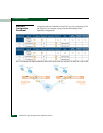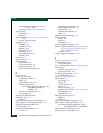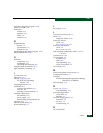
g-4
Glossary
IP Abbreviation of Internet Protocol, pronounced as two separate
letters. IP specifies the format of packets, also called datagrams, and
the addressing scheme. Most networks combine IP with a
higher-level protocol called Transport Control Protocol (TCP),
which establishes a virtual connection between a destination and a
source.
iSCSI iSCSI is Internet SCSI (Small Computer System Interface), a new
Internet Protocol (IP)-based storage networking standard for linking
data storage facilities, developed by the Internet Engineering Task
Force (IETF). By carrying SCSI commands over IP networks, iSCSI
is used to facilitate data transfers over intranets and to manage
storage over long distances. The iSCSI protocol is among the key
technologies expected to help bring about rapid development of the
storage area network (SAN) market, by increasing the capabilities
and performance of storage data transmission. Because of the
ubiquity of IP networks, iSCSI can be used to transmit data over
local area networks (LANs), wide area networks (WANs), or the
Internet and can enable location-independent data storage and
retrieval.
isochronous Signals that are dependent on some uniform timing or carry their
own timing information embedded as part of the signal.
LAN See Local Area Network.
Local Area Network A geographically localized network consisting of both hardware and
software. LANs link personal computers, workstations, printers, file
servers, and other peripherals.
MAC See Message Authentication Code.
MAN See Metropolitan Area Network.
Management Information
Base
A database of network performance information that is stored on a
Network Agent for access by a Network Management Station. MIB
consists of a repository of characteristics and parameters managed in
a network device such as a NIC, hub, switch, or router.
Message Authentication
Code
In computer security, a value that is a part of a message or
accompanies a message and is used to determine that the contents,
origin, author, or other attributes of all or part of the message are as
they appear to be.
Metropolitan Area Network A loosely defined term to describe a data network covering an area
larger than a Local Area Network (LAN) but less than a Wide Area
Network (WAN). A MAN typically interconnects two or more
LANs, may operate at a higher speed, may cross administrative
boundaries, and may use multiple access methods.
MIB See Management Information Base.


















